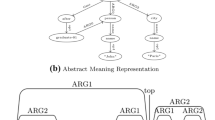Abstract
Frame semantics is a theory of meaning in natural language, which defines the structure of the lexical semantic resources known as framenets. Both framenets and frame semantics have proved useful for a number of natural language processing (NLP) tasks. However, in this connection framenets have often been criticized for their limited coverage. A proposed reasonable-effort solution to this problem is to develop domain-specific (sublanguage) framenets to complement the corresponding general-language framenets for particular NLP tasks, and in the literature we find such initiatives covering domains such as medicine, soccer, and tourism. In this paper, we report on building a framenet to cover the terms and concepts encountered in descriptive linguistic grammars (written in English) i.e. a framenet for the linguistic domain (LingFN) to complement the general-language BFN.
Access this chapter
Tax calculation will be finalised at checkout
Purchases are for personal use only
Similar content being viewed by others
Notes
- 1.
Labels of FEs and frames are conventionally set in small caps.
- 2.
Most of the framenets – including BFN – have been developed in the context of linguistic lexicology, even if several of them have been used in NLP applications (again including BFN). The Swedish FrameNet (SweFN) forms a notable exception in this regard, having been built from the outset as a lexical resource for NLP use and only secondarily serving purposes of linguistic research [2, 6].
- 3.
- 4.
- 5.
- 6.
- 7.
References
Baker, C.F., Fillmore, C.J., Lowe, J.B.: The Berkeley FrameNet project. In: Proceedings of ACL/COLING 1998, pp. 86–90. ACL, Montreal (1998). https://doi.org/10.3115/980845.980860
Borin, L., Dannélls, D., Forsberg, M., Kokkinakis, D., Toporowska Gronostaj, M.: The past meets the present in Swedish FrameNet++. In: 14th EURALEX International Congress, pp. 269–281. EURALEX, Leeuwarden (2010)
Borin, L., Forsberg, M., Olsson, L.J., Uppström, J.: The open lexical infrastructure of Språkbanken. In: Proceedings of LREC 2012, pp. 3598–3602. ELRA, Istanbul (2012)
Borin, L., Toporowska Gronostaj, M., Kokkinakis, D.: Medical frames as target and tool. In: FRAME 2007: Building Frame Semantics Resources for Scandinavian and Baltic Languages. (Nodalida 2007 Workshop Proceedings), pp. 11–18. NEALT, Tartu (2007)
Chiarcos, C.: Ontologies of linguistic annotation: survey and perspectives. In: Proceedings of LREC 2012, pp. 303–310. ELRA, Istanbul (2012)
Dannélls, D., Borin, L., Forsberg, M., Friberg Heppin, K., Gronostaj, M.T.: Swedish FrameNet. In: Dannélls, D., Borin, L., Friberg Heppin, K. (eds.) The Swedish FrameNet++: Harmonization, Integration, Method Development and Practical Language Technology Applications, pp. 37–65. John Benjamins, Amsterdam (forthcoming)
Dannélls, D., Borin, L., Friberg Heppin, K. (eds.): The Swedish FrameNet++: Harmonization, Integration, Method Development and Practical Language Technology Applications. John Benjamins, Amsterdam (forthcoming)
Fillmore, C.J.: Frame semantics and the nature of language. In: Annals of the New York Academy of Sciences, vol. 280, no. 1, pp. 20–32 (1976). https://doi.org/10.1111/j.1749-6632.1976.tb25467.x
Fillmore, C.J.: Scenes-and-frames semantics. In: Zampolli, A. (ed.) Linguistic Structures Processing, pp. 55–81. North Holland, Amsterdam (1977)
Fillmore, C.J.: Frame semantics. In: Linguistic Society of Korea. Linguistics in the Morning Calm, pp. 111–137. Hanshin Publishing Co., Seoul (1982)
Gildea, D., Jurafsky, D.: Automatic labeling of semantic roles. Comput. Linguist. 28(3), 245–288 (2002). https://doi.org/10.1162/089120102760275983
Grierson, G.A.: A Linguistic Survey of India, vol. I-XI. Government of India, Central Publication Branch, Calcutta (1903–1927)
Hasegawa, Y., Lee-Goldman, R., Kong, A., Akita, K.: FrameNet as a resource for paraphrase research. Constructions Frames 3(1), 104–127 (2011)
Malm, P., Ahlberg, M., Rosén, D.: Uneek: a web tool for comparative analysis of annotated texts. In: Proceedings of the IFNW 2018 Workshop on Multilingual FrameNets and Constructicons at LREC 2018, pp. 33–36. ELRA, Miyazaki (2018)
Manning, C.D., Surdeanu, M., Bauer, J., Finkel, J., Bethard, S.J., McClosky, D.: The Stanford CoreNLP natural language processing toolkit. In: Proceedings of ACL 2014, pp. 55–60. ACL, Baltimore (2014). http://www.aclweb.org/anthology/P/P14/P14-5010
Ponzetto, S.P., Strube, M.: Exploiting semantic role labeling, WordNet and Wikipedia for coreference resolution. In: Proceedings of HLT 2006, pp. 192–199. ACL, New York (2006). http://www.aclweb.org/anthology/N/N06/N06-1025
Shen, D., Lapata, M.: Using semantic roles to improve question answering. In: Proceedings of EMNLP-CoNLL 2007, pp. 12–21. ACL, Prague (2007). http://www.aclweb.org/anthology/D/D07/D07-1002
Surdeanu, M., Harabagiu, S., Williams, J., Aarseth, P.: Using predicate-argument structures for information extraction. In: Proceedings of ACL 2003, pp. 8–15. ACL, Sapporo (2003). http://www.aclweb.org/anthology/P03-1002
Torrent, T.T., et al.: Multilingual lexicographic annotation for domain-specific electronic dictionaries: the Copa 2014 FrameNet Brasil project. Constructions Frames 6(1), 73–91 (2014)
Virk, S.M., Borin, L., Saxena, A., Hammarström, H.: Automatic extraction of typological linguistic features from descriptive grammars. In: Ekštein, K., Matoušek, V. (eds.) TSD 2017. LNCS (LNAI), vol. 10415, pp. 111–119. Springer, Cham (2017). https://doi.org/10.1007/978-3-319-64206-2_13
Wu, D., Fung, P.: Semantic roles for SMT: a hybrid two-pass model. In: Proceedings of HLT-NAACL 2009, pp. 13–16. ACL, Boulder (2009). http://dl.acm.org/citation.cfm?id=1620853.1620858
Acknowledgments
The work presented here was funded partially by the Swedish Research Council as part of the project South Asia as a linguistic area? Exploring big-data methods in areal and genetic linguistics (2015–2019, contract no. 421-2014-969), and partially by the Dictionary/Grammar Reading Machine: Computational Tools for Accessing the World’s Linguistic Heritage (DReaM) Project awarded 2018-2010 by the Joint Programming Initiative in Cultural Heritage and Global Change, Digital Heritage and Riksantikvarieämbetet, Sweden.
Author information
Authors and Affiliations
Corresponding author
Editor information
Editors and Affiliations
Rights and permissions
Copyright information
© 2023 Springer Nature Switzerland AG
About this paper
Cite this paper
Virk, S.M., Klang, P., Borin, L., Saxena, A. (2023). LingFN: A Framenet for the Linguistic Domain. In: Gelbukh, A. (eds) Computational Linguistics and Intelligent Text Processing. CICLing 2019. Lecture Notes in Computer Science, vol 13451. Springer, Cham. https://doi.org/10.1007/978-3-031-24337-0_27
Download citation
DOI: https://doi.org/10.1007/978-3-031-24337-0_27
Published:
Publisher Name: Springer, Cham
Print ISBN: 978-3-031-24336-3
Online ISBN: 978-3-031-24337-0
eBook Packages: Computer ScienceComputer Science (R0)




